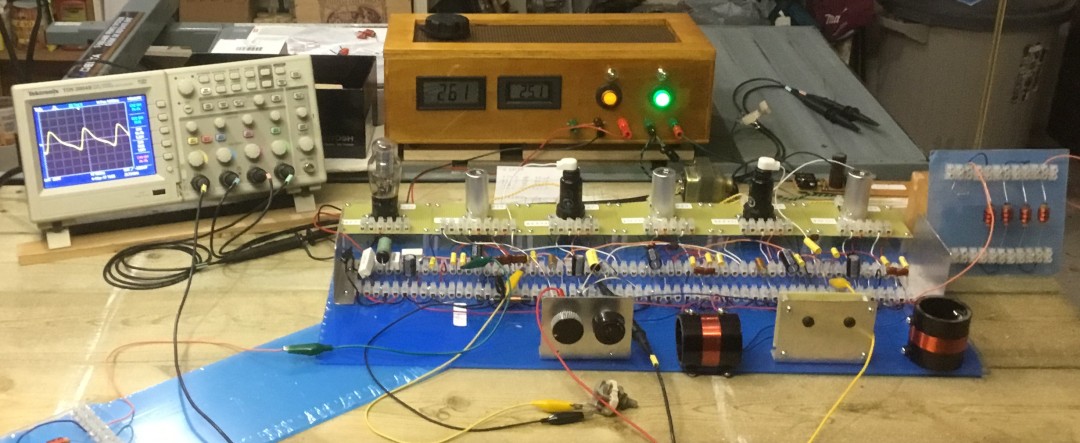Mark, you might want to lift those air coils off of your wooden bench by at least 1". I recommend a plastic spacer of some sort. Heck, lift the entire thing up a couple of inches. Wood isn't entirely blameless when it comes to capacitance. I'd mount the antennas on something plastic too, rather than wood.
Your write-up is nice and I pretty much agree with it. I think one of the big mysteries when technical people are trying to figure out the Theremin is the inductance in series with the antenna. Thierry explains it via mathematics, but I like to look at it as the main or dominant LC tank, stimulated by and influencing resonance of the oscillator LC tank, with the relative tuning between them altering the shape of the heterodyned pitch response. I don't like this topology because I find it very difficult to tune, and believe the best tuning would be a variable C antenna pad (fairly squirrelly due to the 3x effect on heterodyned pitch) along with a second tuning control for the fixed oscillator. Or, somewhat equivalently, have tuning controls for both the fixed and variable oscillators on the front panel (perhaps one knob that alters both, and another that changes the ratio between them, kind of like volume and balance). That way the user could compensate for a variety of intrinsic C playing environments.
The article you point to (http://www.dogstar.dantimax.dk/theremin/thersens.htm) is perhaps misleading. For a simple Theremin (without the series inductance) tuned so that there is a far-field null, I don't believe one can do anything to alter the basic musical sensitivity (in terms of octaves of response). Capacitive padding at the antenna will lower absolute sensitivity, but musically will only lower the overall pitch. This is easy to understand mathematically: the ear perceives pitch logarithmically, so we need to feed it an exponentially based pitch in order to hear a linear sounding response. Multiplying in the exponential domain (changing the absolute sensitivity) is the same as adding in the logarithmic domain (changing the relative pitch). That article doesn't even discuss the log pitch response of the ear, which is a critical omission. I've dubbed this inability to alter the musical sensitivity the "invariant" and I believe it is why you don't see any linear analog Theremins with, say, a 2 octave range (or something more playable than the standard 6 or so octaves).
Have you experimented at all with mains hum reduction? I've found a simple resistor (100k to 1Meg) from antenna to ground acts as an RC with the intrinsic C of the antenna, providing a lot of low cut at mains frequencies. It's also a Q killer, so I tend to avoid using it, but may experiment with adding a fairly high value here in the future.
I think you should emphasize the positive aspects of oscillator decoupling in your article. Coupling can give a richer waveform in the lower octave, and can give a silent instrument if left alone, but at the expense of an even more non-linear playing response down there. I don't think the trade-off is worth it.




